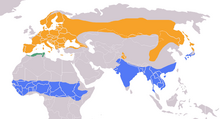
Picinae containing the true woodpeckers is one of four subfamilies that make up the woodpecker family Picidae. True woodpeckers are found over much of the world, but do not occur in Madagascar or Australasia.
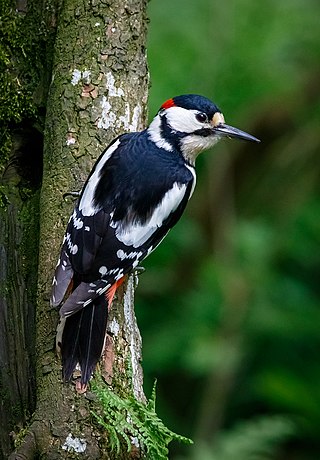
The great spotted woodpecker is a medium-sized woodpecker with pied black and white plumage and a red patch on the lower belly. Males and young birds also have red markings on the neck or head. This species is found across the Palearctic including parts of North Africa. Across most of its range it is resident, but in the north some will migrate if the conifer cone crop fails. Some individuals have a tendency to wander, leading to the recolonisation of Ireland in the first decade of the 21st century and to vagrancy to North America. Great spotted woodpeckers chisel into trees to find food or excavate nest holes, and also drum for contact and territorial advertisement; like other woodpeckers, they have anatomical adaptations to manage the physical stresses from the hammering action. This species is similar to the Syrian woodpecker.

The European green woodpecker is a large green woodpecker with a bright red crown and a black moustache. Males have a red centre to the moustache stripe which is absent in females. It is resident across much of Europe and the western Palearctic but in Spain and Portugal it is replaced by the similar Iberian green woodpecker.

Woodpeckers are part of the bird family Picidae, which also includes the piculets, wrynecks and sapsuckers. Members of this family are found worldwide, except for Australia, New Guinea, New Zealand, Madagascar and the extreme polar regions. Most species live in forests or woodland habitats, although a few species are known that live in treeless areas, such as rocky hillsides and deserts, and the Gila woodpecker specialises in exploiting cacti.
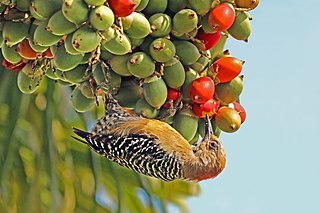
Nine families of largely arboreal birds make up the order Piciformes, the best-known of them being the Picidae, which includes the woodpeckers and close relatives. The Piciformes contain about 71 living genera with a little over 450 species, of which the Picidae make up about half.

The piculets are a distinctive subfamily, Picumninae, of small woodpeckers which occur mainly in tropical South America, with just three Asian and one African species.

The Eurasian wryneck or northern wryneck is a species of wryneck in the woodpecker family. They mainly breed in temperate regions of Europe and Asia. Most populations are migratory, wintering in tropical Africa and in southern Asia from Iran to the Indian subcontinent, but some are resident in northwestern Africa. It is a bird of open countryside, woodland and orchards.

The red-throated wryneck, also known as the rufous-necked wryneck or red-breasted wryneck, is a species of wryneck in the woodpecker family closely related to the Eurasian wryneck. Its three subspecies are resident in much of sub-Saharan Africa in open habitats with some trees. It is a slim, elongated bird about 19 cm (7.5 in) in length, with a small head, fine bill, long fan-shaped tail and cryptic plumage intricately patterned in greys and browns. The sexes look similar, although males are slightly larger. The diet of the adults and young is almost entirely ants at all stages of their life cycles. The call of the red-throated wryneck is a series of repeated harsh, shrill notes. When threatened, a bird will twist its neck and head in a snake-like manner while making a hissing sound, presumably to deter predators.
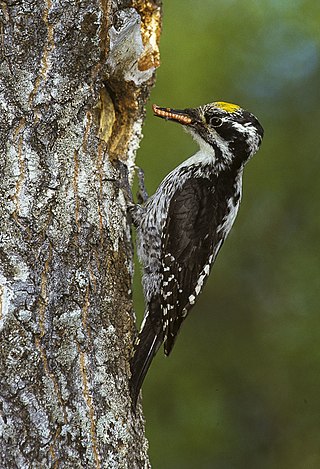
The Eurasian three-toed woodpecker is a medium-sized woodpecker that is found from northern Europe across northern Asia to Japan.

The middle spotted woodpecker is a European woodpecker belonging to the genus Dendrocoptes.

The rufous woodpecker is a medium-sized brown woodpecker native to South and Southeast Asia. It is short-billed, foraging in pairs on small insects, particularly ants and termites, in scrub, evergreen, and deciduous forests and is noted for building its nest within the carton nests of arboreal ants in the genus Crematogaster. It was for sometime placed in the otherwise Neotropical genus Celeus but this has been shown to be a case of evolutionary convergence and molecular phylogenetic studies support its placement in the monotypic genus Micropternus.

The red-necked woodpecker is a species of bird in subfamily Picinae of the woodpecker family Picidae. It is found in every mainland South American country except Argentina, Chile, Paraguay, and Uruguay.

The blond-crested woodpecker is a species of bird in the woodpecker family Picidae. It is found in Argentina, Brazil, and Paraguay.

The waved woodpecker is a species of bird in subfamily Picinae of the woodpecker family Picidae. It is found in Bolivia, Brazil, Colombia, Ecuador, French Guiana, Guyana, Peru, Suriname, and Venezuela.

Meiglyptes is a genus of Southeast Asian birds in the woodpecker family Picidae.
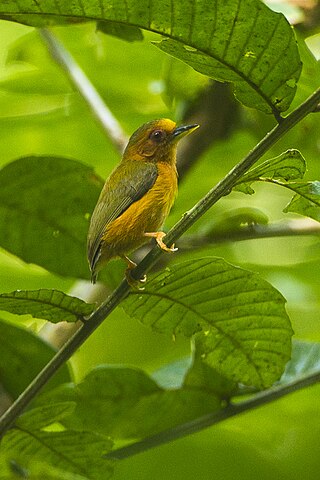
The rufous piculet is a species of bird in the family Picidae. It is found in Brunei, Indonesia, Malaysia, Myanmar, and Thailand. Its natural habitats are subtropical or tropical moist lowland forests and subtropical or tropical moist montane forests. This species is one of the world's smallest woodpeckers and is the smallest woodpecker found outside the Americas. In this species the length can range from 8 to 10 cm and the average body mass is around 9.2 g (0.32 oz).
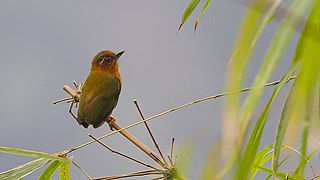
The white-browed piculet is a species of bird in the family Picidae. It is found in Bangladesh, Bhutan, Cambodia, India, Laos, Myanmar, Nepal, Thailand, and Vietnam. Its natural habitats are temperate forests and subtropical or tropical moist montane forests.

Picumnus is a large genus of piculets. With a total length of 8–10 cm (3–4 in), they are among the smallest birds in the woodpecker family. All species are found in the Neotropics except the speckled piculet that has a wide distribution in China, India and Southeast Asia.
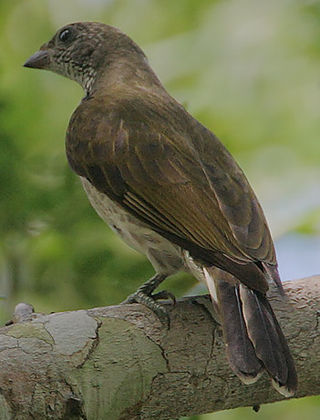
Picides is an infraorder of the order Piciformes that includes woodpeckers and honeyguides. The honeyguides were thought to be closely related to the barbets, as their aerial displays and vocalizations are more similar to each other than either are to woodpeckers. However, phylogenetic analysis has shown that honeyguides and woodpeckers are indeed sister taxa.

Yungipicus is a genus of woodpeckers in the family Picidae native to Asia. The species in this genus were previously placed in the genus Dendrocopos.

